Jon Reed's Blog, page 8
October 27, 2017
How to choose an agent – which of these 7 types is right for you?
You choose an agent as much as an agent chooses you. But which one is right for you? Kirsty McLachlan looks at what different types of agent can offer.

5 minutes to read
You’ve written your book, spent months, possibly years writing it and you need to find an agent to represent it for you. An agent works for you – on your behalf – and the relationship should be a two-way street. As much as an agent chooses an author, so an author must choose an agent. As an agent, I’ve heard endless stories of mismatches, relationships that haven’t worked out and unhappy authors who simply feel ‘unloved’ by their agents. So how to choose an agent?
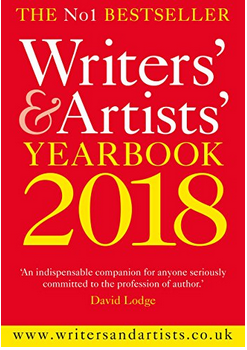 Firstly, research, research, and research. Spend time on this and you will ensure that the submission list you draw up will fit your book. There is no point sending your book to every agent in London. Get Writer’s Market (USA) or the Writers’ & Artists’ Yearbook (UK). These will give you the address, website and crucial details of every agent. They are your first port of call, but you also need to investigate at a deeper level – look at the agents’ websites, look at the books they represent, try and hear them talk at events and festivals – and get a sense of who they really are.
Firstly, research, research, and research. Spend time on this and you will ensure that the submission list you draw up will fit your book. There is no point sending your book to every agent in London. Get Writer’s Market (USA) or the Writers’ & Artists’ Yearbook (UK). These will give you the address, website and crucial details of every agent. They are your first port of call, but you also need to investigate at a deeper level – look at the agents’ websites, look at the books they represent, try and hear them talk at events and festivals – and get a sense of who they really are.
Subscribe to The Bookseller magazine, which will keep you up to date with deals and movements of agents. The industry is always in flux – agents move to different agencies and agencies are being bought by other agencies etc – so you need to be on top of the industry news.
Getting an agent is like playing the dating game: you need to work out exactly who would be right for you and your writing. I’ve identified seven types of agents – there are others (and some combine some or more of these ‘types’) – but it will help you to work out exactly the ‘sort’ of agent you want:
1. The young and hungry agent (YAHA)
The YAHA is always on the lookout for books, they have small lists but are building them so you won’t get ‘sorry, I’m not taking on clients at the moment’ rejection letters from them. They are out there and busy in the publishing world – speaking at festivals, events and literary evenings. The YAHA is on Twitter and whirling around the social media networks, chatting to authors and to other YAHAs. Any authors they take on will be given lots of attention and they are always thinking long term. YAHAs are in touch with all that is new – they are the ‘new kids on the block’ but the better for it.
2. The more established agent (MEA)
The MEAs have been around since the days of long lunches and deals on napkins. They know how to make a deal in five minutes, on the street, and made with a handshake. They have Power – their authors have all written five books at least and sold in high figures. The MEA isn’t really looking to add to their list. They have genuine friendships with publishers and can actually get an editor on the phone – a rare thing these days. When they submit a debut, it makes an impact, it becomes a MEA book and editors sit up and take note. On the down side, MEAs have assistants, secretaries and rights people, all who stop you getting to the agent in question.
3. The ‘can do’ agent (CDA)
The ‘can do’ agent, or the ‘360 degree agent’, can quite simply do stuff for you. They are working on all levels and can see the bigger picture, of which your book is just one part. So they can sell foreign rights, US rights, Film/TV, stage, can arrange speaking engagements and newspaper columns. With publishing deals getting smaller, CDAs make their commission from other streams of income. CDAs are sometimes called the New Model Agent. As income from books shrink it is worth keeping your eye on these.
4. The corporate agent (CA)
The CA works within a pack of agents. A pack can be more powerful that a sole trader (below). They work as a team within the pack and have lots of support. The CA recognizes that publishing is a business and can be run as one. A good CA runs a tight ship, efficient and slick. They have nice offices. A bad CA is a dinosaur and gathers other dinosaurs around them – they move slowly and hold onto the mast as the ship slowly goes down.
5. The sole trader agent (STA)
There are many STAs in the agency world. It’s knowing who to choose – and who not to. Their lists are generally small, they have the ability to be nimble and change according to changes in the industry. Often STAs are expanding their lists steadily – they take on few writers but they really feel passionate about their list. They don’t have any support but can multitask – you will always get them on the phone and face-to-face meetings are a given.
6. The nurturer agent (NA)
Nurturers are wonderful if you want lots of input in your book. They can edit (they have often been readers or editors in a publishing house) and will go through your book line by line. Do you want that sort of input and care and attention? Editors are demanding manuscripts to be as polished as possible now so nurturers are coming in their own. They can ensure a proposal is brilliant and that novels really work – even if it takes four or five drafts to do so. NAs have small lists and spend a lot of time on each client.
7. The deal-maker agent (DMA)
DMAs are frighteningly prolific with their deal making. These are the agents who appear again and again in The Bookseller listing their deals done that week. They speak of high six-figure deals and move with the kind of speed of a jaguar on course for their prey. Publishers are naturally wary of DMAs but can’t leave them alone. Be afraid: be very afraid. If you want your book sold – and for lots of money – these are the ones to go to. Don’t expect lots of cosy phone calls, coffees or one-to-ones though.
Choose an agent that’s right for you
Draw up a wish list. What do you want your agent to do for you? Do you want lots of editorial input or do you want someone who will really make the high level deals? Do you want to work with a sole trader or within part of a bigger organization? Be focused with your submissions and they might just hit the right spot.
 This article first appeared in our NaNoWriMo-themed issue 3 of Publishing Talk Magazine – also available as a Kindle edition.
This article first appeared in our NaNoWriMo-themed issue 3 of Publishing Talk Magazine – also available as a Kindle edition.
Save
Save
Save
Save
Save
Save
Save
Save
Save
The post How to choose an agent – which of these 7 types is right for you? appeared first on Publishing Talk.


October 17, 2017
NaNoWriMo – The Haynes Manual
Elizabeth Haynes tells Danuta Kean how she researches her bestselling crime novels – and how NaNoWriMo helps her write.
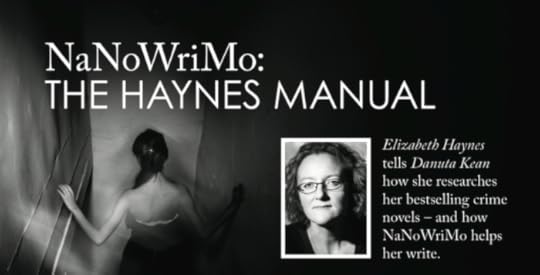
 This interview first appeared in our NaNoWriMo-themed issue 3 of Publishing Talk Magazine (Nov-Dec 2012) – also available as a Kindle edition.
This interview first appeared in our NaNoWriMo-themed issue 3 of Publishing Talk Magazine (Nov-Dec 2012) – also available as a Kindle edition.
It may be a cliché, but bestselling writer Elizabeth Haynes doesn’t care: she has bought a writing shed. The bestselling author of Into the Darkest Corner and Revenge of the Tides wanted a shed after seeing one owned by fellow crime writer Julia Crouch. ‘I saw it and thought: I’m having one of them,’ she says pointing through a sunlit sitting room window to the part of the garden where it will be.
Haynes and Crouch, however, have more than sheds in common: both are successful graduates of National Novel Writing Month – NaNoWriMo to the cognoscenti – and used the internet-based 30-day writing challenge to write novels that have gone on to be bestsellers.
I wrote my first full-length book thanks to NaNoWriMo.
‘I wrote my first full-length book thanks to NaNoWriMo,’ Haynes explains over tea and cake – for me, not her, she’s on Lighter Life, she says. We are in the sitting room of her modern semi in rural north Kent. It feels cosy and familiar, very different to the dark, vicious world of her imagination. The only hint of that is a long bookshelf along one wall, which is crammed with crime novels, many with broken and bruised spines.
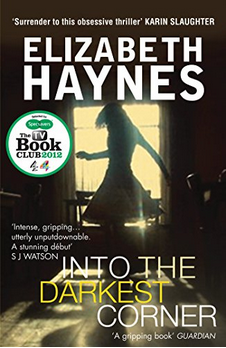 She started using NaNoWriMo in 2005 and completed two manuscripts before hitting pay dirt with Into The Darkest Corner (Myriad Editions), her 2011 bestselling début. The writing challenge enabled her to make the leap from short fiction to something more sustained. ‘I think with our busy lives it’s easy to see writing as a self-indulgent hobby; with careers, families and other demands on our time it’s hard to justify spending time writing just for fun. NaNoWriMo gives you a reason to do just that,’ she explains of why she used it.
She started using NaNoWriMo in 2005 and completed two manuscripts before hitting pay dirt with Into The Darkest Corner (Myriad Editions), her 2011 bestselling début. The writing challenge enabled her to make the leap from short fiction to something more sustained. ‘I think with our busy lives it’s easy to see writing as a self-indulgent hobby; with careers, families and other demands on our time it’s hard to justify spending time writing just for fun. NaNoWriMo gives you a reason to do just that,’ she explains of why she used it.
As with her unpublished NaNoWriMo novels, Into The Darkest Corner began with the germ of an idea and a couple of ‘nebulous’ characters. ‘I’m very careful not to over-think the plot before I start.’ In this case the idea was domestic abuse. She sounds surprised as she recalls: ‘I thought there is a possibility that I could do something with this as I had a beginning, middle and end that I liked.’
It’s hard to justify spending time writing just for fun. NaNoWriMo gives you a reason to do just that.
And what a beginning! A blood-spattered scene sees a woman bludgeoned to death in a ditch. From there Haynes unfolds the story of Catherine, whose meticulous planning had enabled her to escape an abusive relationship. But a phone call reveals her suffering is not behind her. What follows is a plot that twists into a gripping and believable climax that works as genre crime thriller and, thanks to its intelligent portrayal of domestic violence, book group staple.
Given its success, it may be surprising that a multi-million pound imprint wasn’t behind it. Instead it was in the vanguard of a new fiction list from tiny Brighton-based independent Myriad Editions. As a result it was not supported by the advertising clout usually associated with bestselling crime débuts. It didn’t matter: readers loved it, quickly loading it with five star reviews on Amazon UK. Within a short time the book had received over 600 reviews, almost 500 of which awarded five stars – it has now reached 700 out of 900. Amazon recognized its quality by naming it the 2011 Book of the Year.
Key to the novel’s success, says blogger and book prize judge Rhian Davies, is Haynes’s voice. ‘I think her distinct and unique appeal lies in her voice,’ Davies explains. ‘It’s like having your best friend sitting next to you telling you a story.’ Victoria Blunden, Haynes’s editor at Myriad, agrees the author’s knack for creating sympathetic female leads is at the heart of her success. ‘Elizabeth has a knack for creating strong female characters that the reader cares about, and building tension so that the pages turn themselves.’
Originally sent the manuscript with a view to providing feedback, Blunden recalls that even at early draft stage it was obvious the book had potential: ‘The pace of Elizabeth’s storytelling, and the way she’d used the structure of the book to fuel the drama, were completely captivating, and she’d handled her subject matter – the terrifyingly real depiction of an abusive relationship and the attempt to live with the aftermath of trauma – with real sensitivity.’
I explore the characters and unravel the plot by re-writing, rather than planning it out in the first place.
The quality of this early draft reflects what Haynes sees as both the strengths and weaknesses of NaNoWriMo. While writing is quick, she finds the editing process ‘tortuous’. ‘I know of several non-NaNoWriMo authors who complete manuscripts slowly, over a year or more, and then only need to do maybe two drafts with some copy editing to finish off.’ Not so Haynes. ‘I end up writing several drafts, each time exploring the story further – and this takes about a year. I explore the characters and unravel the plot by re-writing, rather than planning it out in the first place.’
The strength of the ‘get it on the page at any cost’ approach is that you relinquish editorial control, letting the words flow in order to meet the daily target. Summing up a struggle faced by most writers – including this one – she adds: ‘Before I tried NaNoWriMo, all my attempts at writing were brief because sooner or later it would feel pointless or I would run out of steam.’
I find the best ideas come to me when I’m writing fast.
NaNoWriMo liberates Haynes, enabling her to write from her Id, unhindered by self-criticism. ‘I find the best ideas come to me when I’m writing fast and don’t have time to say “that’s silly” or “that won’t work” – I just do it, knowing that if it falls flat, I can take things in a different direction when I’m editing.’ She adds: ‘By sacrificing quality over quantity – after all, it’s only about the word count – your creativity is liberated and you write without worrying about anything else.’
Risk-taking with plot is not the only beneficiary from this unfettered method of writing a first draft. Haynes is adamant her leads have strong voices because she does not ‘over-think’ her characters at this stage. ‘It takes a few days or a week of writing for things to gain momentum, and then I find the voices of the people I’ve created become clearer. That’s when it really gets exciting.’
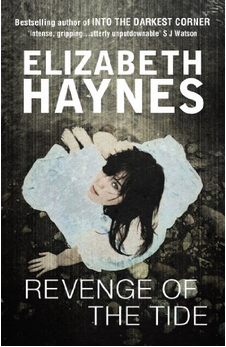 I suspect her continued use of NaNoWriMo is also about not over-thinking the reception of each new book now she is tied into a five-book deal with Sphere. She admits as much when she tells me using the site for Revenge of the Tide, her second published novel, was ‘very different’. The greatest pressure with the book came during editing. By then her début was accelerating up the charts. ‘I suddenly realized that I had an awful lot to live up to,’ she recalls, pulling a face of mock fear, followed by a warm smile.
I suspect her continued use of NaNoWriMo is also about not over-thinking the reception of each new book now she is tied into a five-book deal with Sphere. She admits as much when she tells me using the site for Revenge of the Tide, her second published novel, was ‘very different’. The greatest pressure with the book came during editing. By then her début was accelerating up the charts. ‘I suddenly realized that I had an awful lot to live up to,’ she recalls, pulling a face of mock fear, followed by a warm smile.
The novel, though different in character to her début, retains her trademark believable female lead, flawed in character and judgment. ‘I was anxious to make Genevieve quite different to Catherine,’ she says of Tide’s narrator. That is an understatement: Genevieve supplements her wages from a job in marketing by working weekends as a pole dancer. A less than reliable narrator, she is all ambition and no insight, which means the story unfolds at a seductive pace as she becomes enmeshed in a world that operates on the fringes of criminality and exploitation.
For Genevieve money is everything, it buys her the life she desires (in this case one refurbishing a barge on which she can live without ties). Haynes subtly creates a character more complex than might be expected in a genre thriller, one who is fearless, but also remarkably naive – she goes from selling financial products to selling her body with the blithe rapaciousness of a reality show contestant who disrobes for Nuts. As Genevieve narrates, it is easy to believe the ethical creep that leads her from a bit of a laugh on a Friday night to consorting with gangland figures better avoided.
For both books, Haynes drew on her experience as a police analyst for Kent Constabulary. The day job involves analyzing crime patterns. Finding links – geographical and temporal – and patterns of crime helps detectives crack cases and commanders direct resources. It also provides her with an intimate knowledge of crime, though she emphasizes her novels are fiction.
‘It’s more subtle than that,’ she says of how the job helps her write. Into the Darkest Corner was inspired by reports of domestic abuse she read for work. ‘I was very struck by how I had probably had a stereotype of the kind of woman or couple who would be involved in domestic abuse. I had that perception thrown out of the water. There are lots of reasons why women and men stay in abusive relationships. They are not always the most obvious ones.’ It is a neat summary of what happens to Catherine.
I still have to pinch myself that I am writing and published and have five books that I can write.
With Revenge of the Tides she used her understanding of organized crime. The actuality of the novel came from first hand research of pole dancing, including a weekly class. ‘The warm up nearly killed me.’ We are both laughing: I’m trying to imagine Haynes – more WI than Spearmint Rhino – writhing round a pole.
She also met women who worked in the industry. An active listener, she quickly recognized the disconnect between the excuses women use for taking the job – to pay university fees or buy homes – and their inability to escape it once they have bought their dream. ‘It’s very difficult to give up that kind of money, even if they don’t want to go back to it.’ There is a note of sadness in her voice: not judgment, but sympathy for freedom compromised by money. ‘To leave and feel sad about going back means there has to be an element in your mind that says this is not a career choice.’
Haynes has been luckier. Next February Myriad publishes her third novel, Human Remains, written during NaNoWriMo 2011. It will be, she promises, ‘really grim and dark’. ‘It is another standalone, but all three fit together nicely as psychological thrillers.’ After that she is tied into a five novel deal with Sphere in the UK and HarperCollins in the US.
The first of the series is a reworking of her second NaNoWriMo novel, and sounds experimental in a good way. ‘I intend to use an awful lot of source text: witness statements; forensic reports; emails. The idea is that the reader has the same access to source documents that the investigators have and can solve it along with them.’ She pauses when I ask how it feels to be one of NaNoWriMo’s most successful graduates? ‘I still have to pinch myself that I am writing and published and have five books that I can write,’ she replies. ‘I mean where can it go from there? It’s amazing.’
Elizabeth Haynes’s Guide to NaNoWriMo
NaNoWriMo gives you the ultimate deadline pressure
It is a tremendous motivational boost by writing alongside hundreds of thousands of other people, all around the world, with an element of competition as well as support
It has motivational tools there to keep you going – discussion boards which allow you to pose plot problems, ask research questions (someone out there is bound to be an expert in whichever random situation your character has found herself)
Participants organise impromptu ‘sprints’ through social media in which you write for an agreed period of time, say 10 minutes, and then compare word counts
It’s great for meeting other writers in your local area. I now have some great writing friends I can meet with all year round
It’s fun writing at speed, allowing your characters to do unexpected things and setting yourself seemingly impossible writing challenges
If you’ve ever had the urge to write a novel, but never had the time; or if you thought it was pointless doing it because the likelihood of publication is so small, then NaNoWriMo is for you.
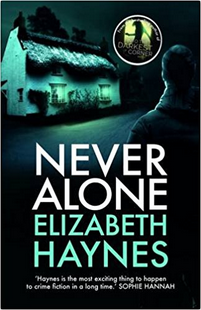 UPDATE: Elizabeth Haynes’s latest book Never Alone is out now.
UPDATE: Elizabeth Haynes’s latest book Never Alone is out now.
 Find more NaNoWriMo advice in issue 3 of Publishing Talk Magazine.
Find more NaNoWriMo advice in issue 3 of Publishing Talk Magazine.
Save
Save
Save
Save
Save
Save
Save
Save
Save
The post NaNoWriMo – The Haynes Manual appeared first on Publishing Talk.


August 17, 2017
Room to Write – Isabel Losada writes narrative nonfiction anywhere and everywhere
Writing in exotic locations – and occasionally shop windows – is all in a day’s work for narrative nonfiction author Isabel Losada.
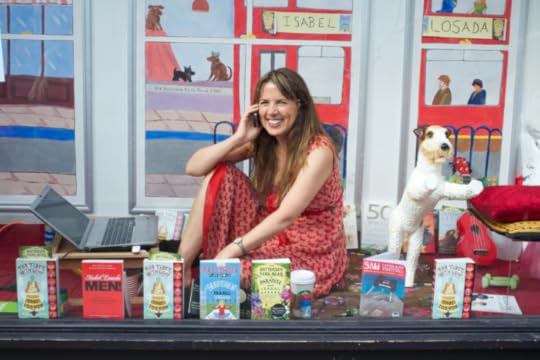
This article first appeared in issue 2 of Publishing Talk Magazine.
3 minutes to read

One of the joys of narrative nonfiction is that I write anywhere and everywhere. I wrote freehand in notebooks while suffering from potentially fatal altitude sickness in Tibet. I scribbled, in an altered state of consciousness, lying on a bamboo mat under the moon having swallowed ayahuasca, in the Amazonian jungle.
 I have made notes just before walking on fire and just after walking on fire. I have pulled out my famous Lamy pen while a tiny plane climbs through the clouds and I’ve volunteered to jump out. I’ve smuggled tiny notebooks in sponge bags onto Vipassana retreats (where writing is forbidden) and hidden in the loo to record the day. I’ve taken time out in the middle of a tantric sex workshop, while all kinds of interesting things are happening, to record an impression, a sensation or a feeling.
I have made notes just before walking on fire and just after walking on fire. I have pulled out my famous Lamy pen while a tiny plane climbs through the clouds and I’ve volunteered to jump out. I’ve smuggled tiny notebooks in sponge bags onto Vipassana retreats (where writing is forbidden) and hidden in the loo to record the day. I’ve taken time out in the middle of a tantric sex workshop, while all kinds of interesting things are happening, to record an impression, a sensation or a feeling.
I’m told that what is unusual about my writing is that it is like a letter from your best friend. And indeed that is how I view my reader. I love writing so for me anywhere and any time is a good place. In the examples above I know that I will never be able to write, for example, about the experience of a ten day silent retreat if I begin the writing at day 11. I have to write it while I’m there. It’s like the difference between live TV and a dry recording.
Another example was writing in a tiny B&B in Northern India the night before interviewing His Holiness the Dalai Lama. When I wrote ‘I can’t believe I’m meeting The Dalai Lama tomorrow’ (I had been reading about his life and about Tibet for a year by then) I know that my readers had no trouble believing me. And of course it was all in the present tense. Imagine the difference between that sentence and ‘I was very excited about the fact that I was to be meeting The Dalai Lama the following day.’ No comparison. So I write where I am.
“I have adventures and then I write about them with the same enthusiasm you may sit down to tell a great tale to someone you love.” – Isabel Losada
Also I’m not one of those poor fiction writers (I feel very sorry for them) that has to discipline themselves to write a certain amount every day. I have adventures and then I write about them with the same enthusiasm you may sit down to tell a great tale to someone you love. The only exception is that I could never write anywhere noisy. One hundred percent concentration is required.
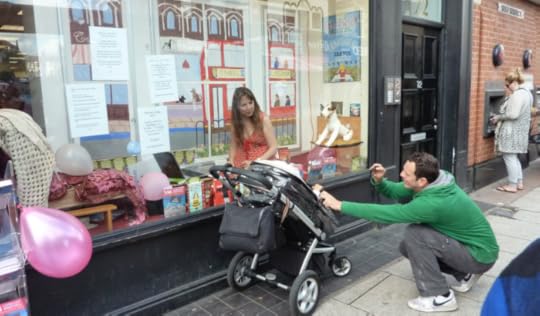
The idea of writing is shop windows as I have now done in Waterstones in London and in W.H. Smith in Paris – only works if you have something very simple to do. It’s just not possible to write anything except emails when there is any distraction. So ‘Author, in residence, in window.’ Isn’t really true – I’m there but not writing books at the time.
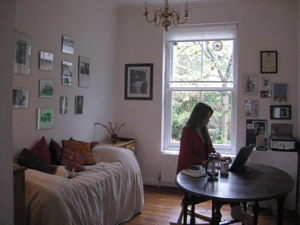
So where do I write? Anywhere at all that is quiet.
There is another question though. Where do I copy out the notebooks? Where do I edit? Where do I re-write? Only one place.
Alone. In the silence. At my desk.
[image error] UPDATE: Isabel Losada’s new book, Sensation: Advenures in Sex, Love and Laughter, is available now.
UPDATE: Isabel Losada’s new book, Sensation: Advenures in Sex, Love and Laughter, is available now.
Save
Save
Save
Save
Save
Save
Save
Save
Save
Save
Save
Save
Save
The post Room to Write – Isabel Losada writes narrative nonfiction anywhere and everywhere appeared first on Publishing Talk.


Room to Write – Isabel Losada writes narrative non-fiction anywhere and everywhere
Writing in exotic locations – and occasionally shop windows – is all in a day’s work for narrative non-fiction author Isabel Losada.

This article first appeared in issue 2 of Publishing Talk Magazine.
3 minutes to read

One of the joys of narrative non-fiction is that I write anywhere and everywhere. I wrote freehand in notebooks while suffering from potentially fatal altitude sickness in Tibet. I scribbled, in an altered state of consciousness, lying on a bamboo mat under the moon having swallowed ayahuasca, in the Amazonian jungle.
 I have made notes just before walking on fire and just after walking on fire. I have pulled out my famous Lamy pen while a tiny plane climbs through the clouds and I’ve volunteered to jump out. I’ve smuggled tiny notebooks in sponge bags onto Vipassana retreats (where writing is forbidden) and hidden in the loo to record the day. I’ve taken time out in the middle of a tantric sex workshop, while all kinds of interesting things are happening, to record an impression, a sensation or a feeling.
I have made notes just before walking on fire and just after walking on fire. I have pulled out my famous Lamy pen while a tiny plane climbs through the clouds and I’ve volunteered to jump out. I’ve smuggled tiny notebooks in sponge bags onto Vipassana retreats (where writing is forbidden) and hidden in the loo to record the day. I’ve taken time out in the middle of a tantric sex workshop, while all kinds of interesting things are happening, to record an impression, a sensation or a feeling.
I’m told that what is unusual about my writing is that it is like a letter from your best friend. And indeed that is how I view my reader. I love writing so for me anywhere and any time is a good place. In the examples above I know that I will never be able to write, for example, about the experience of a ten day silent retreat if I begin the writing at day 11. I have to write it while I’m there. It’s like the difference between live TV and a dry recording.
Another example was writing in a tiny B&B in Northern India the night before interviewing His Holiness the Dalai Lama. When I wrote ‘I can’t believe I’m meeting The Dalai Lama tomorrow’ (I had been reading about his life and about Tibet for a year by then) I know that my readers had no trouble believing me. And of course it was all in the present tense. Imagine the difference between that sentence and ‘I was very excited about the fact that I was to be meeting The Dalai Lama the following day.’ No comparison. So I write where I am.
“I have adventures and then I write about them with the same enthusiasm you may sit down to tell a great tale to someone you love.” – Isabel Losada
Also I’m not one of those poor fiction writers (I feel very sorry for them) that has to discipline themselves to write a certain amount every day. I have adventures and then I write about them with the same enthusiasm you may sit down to tell a great tale to someone you love. The only exception is that I could never write anywhere noisy. One hundred percent concentration is required.

The idea of writing is shop windows as I have now done in Waterstones in London and in W.H. Smith in Paris – only works if you have something very simple to do. It’s just not possible to write anything except emails when there is any distraction. So ‘Author, in residence, in window.’ Isn’t really true – I’m there but not writing books at the time.

So where do I write? Anywhere at all that is quiet.
There is another question though. Where do I copy out the notebooks? Where do I edit? Where do I re-write? Only one place.
Alone. In the silence. At my desk.
[image error] UPDATE: Isabel Losada’s new book, Sensation: Advenures in Sex, Love and Laughter, is available to pre-order now.
UPDATE: Isabel Losada’s new book, Sensation: Advenures in Sex, Love and Laughter, is available to pre-order now.
Save
Save
Save
Save
Save
Save
Save
Save
Save
Save
Save
Save
The post Room to Write – Isabel Losada writes narrative non-fiction anywhere and everywhere appeared first on Publishing Talk.


August 11, 2017
10 essential books for writers
Develop your craft with these 10 essential books for writers.
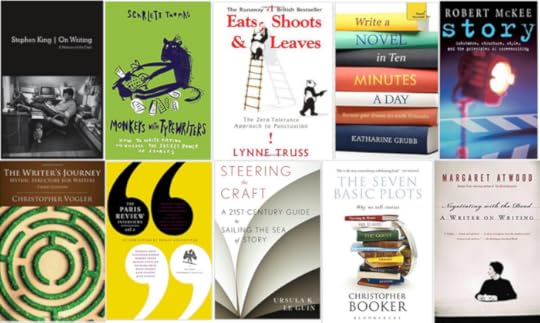
8 minutes to read
“If you don’t have time to read, you don’t have the time (or the tools) to write. Simple as that.” – Stephen King
Stephen King may have been talking about reading fiction when he said that. But sometimes it pays to read books about writing too, starting with the one this quotation comes from: his own bestselling On Writing.
Books about writing are a great source of inspirational soundbites and quotations to be shared on Instagram (see the @publishingtalk Instagram account for some examples). But they are also a source of practical advice to be absorbed and used to develop your own craft. Furthermore, many lift the lid on the process and offer an insight into your favourite writers’ working methods.
Try the following for starters. In the first of an occasional series on books for writers, here are some of the books I have enjoyed and found useful. But I’m sure you have your own favourites. Please add your recommendations in the comments below.
[image error]
 1. On Writing
1. On Writing– A Memoir of the Craft, by Stephen King
What you will learn: To write truthfully.
On Writing is probably the most-quoted book on writing. Stephen King’s critically lauded, million-copy bestseller shares the experiences, habits, and convictions that have shaped him and his work. Immensely helpful and illuminating to any aspiring writer.
“Writing isn’t about making money, getting famous, getting dates, getting laid, or making friends. In the end, it’s about enriching the lives of those who will read your work, and enriching your own life, as well. It’s about getting up, getting well, and getting over. Getting happy, okay? Getting happy.”
– Stephen King, On Writing
[image error]
 2. Negotiating with the Dead
2. Negotiating with the Dead– A Writer on Writing, by Margaret Atwood
What you will learn: What it means to be a writer.
Margaret Atwood is one of my favourite authors, and she too has her own book ‘on writing.’ But this isn’t so much a book about how to write, as about what it means to be a writer.
“What is this writing, anyway, as a human activity or a vocation, or as a profession, or as a hack job, or perhaps even as an art, and why do so many people feel compelled to do it?”
– Margaret Atwood, Negotiating with the Dead
[image error]
 3. Steering the Craft
3. Steering the Craft– A Twenty-First-Century Guide to Sailing the Sea of Story, by Ursula K. Le Guin
What you will learn: To critique your own work.
It’s unsurprising that so many books for writers are written by writers – and this is Ursula K. Le Guin’s. A deceptively short and simple guide to the craft of writing, it started as a course she gave to aspiring writers. Over 10 chapters she addresses the fundamentals of narrative, from the sound of language to sentence construction to point of view. Each chapter combines examples from the global canon with Le Guin’s own witty commentary and an exercise you can do solo or in a group. She also offers a guide to working in writing groups, both face-to-face and online.
“Ultimately you write alone. And ultimately you and you alone can judge your work. The judgment that a work is complete — this is what I meant to do, and I stand by it — can come only from the writer, and it can be made rightly only by a writer who’s learned to read her own work.”
– Ursula K. Le Guin, Steering the Craft
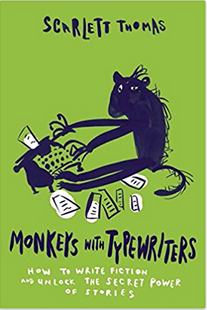 4. Monkeys with Typewriters
4. Monkeys with Typewriters– How to Write Fiction and Unlock the Secret Power of Stories, by Scarlett Thomas
What you will learn: How stories work.
I picked this up because I had previously read Scarlett Thomas’s fiction. But she’s also a creative writing lecturer, and this thick volume is based on her years of teaching at the University of Kent in the UK.
It’s divided into two sections: Theory and Practice. The Theory section explores plots from Plato to The Matrix, from Tolstoy to Toy Story, and will help you create your own. The Practice section has creative exercises, structures, and charts. Including a chapter on ‘How to have ideas’, it breaks down the fiction writing process and shows that everyone has material to write about.
“Have you ever had your heart broken, or broken someone else’s heart? Have you ever won an argument but later realised you were wrong? Have you ever tripped over in public , or spilled wine on someone else’s carpet? … Have you ever edited your life in your head and wondered what would have happened if you’d said or done something else, or if someone else had? …If the answer to these questions is yes, then you almost certainly have what it takes to be a writer, or understand how and why other people write.”
– Scarlett Thomas, Chapter 1, Monkeys with Typewriters
[image error]
 5. Story
5. Story– Substance, Structure, Style and the Principles of Screenwriting, by Robert McKee
What you will learn: Narrative structure.
One of the things I do these days is write screenplays, and I’ve read many books on screenwriting over the years. But I’m an unashamed devotee of McKee. I’ve been on his courses and read his bestselling book Story. For many, this is the screenwriters’ Bible.
Yet it’s not just for screenwriters. If you write novels, you too need to understand the principles outlined in this book. I know novelists who go on McKee’s Story course too. Some publishers routinely send their fiction editors on it.
If you hope to have your novel adapted into a film or TV series, it pays to think about a narrative structure that works on screen from the start. But even if you don’t, the principles outlined in this book will improve your plotting – and your writing.
“Anxious, inexperienced writers obey rules; rebellious, unschooled writers break rules; an artist masters the form. Story is about eternal, universal forms, not formulas.”
– Robert McKee, Introduction to Story
[image error]
 6. The Writer’s Journey
6. The Writer’s Journey– Mythic Structure for Storytellers and Screenwriters, by Christopher Vogler
What you will learn: How to send your archetypes on a journey.
Another book that’s a classic on structure for writers is Vogler’s The Writer’s Journey. Drawing on the depth psychology of Carl Jung and the mythic studies of Joseph Campbell, it relates these ideas to contemporary storytelling. It’s a step-by-step guide through the classic hero’s journey with examples from Star Wars to Pulp Fiction, and includes exercises that will improve your writing.
The book details seven key archetypes, including the Hero, the Mentor and the Herald; and 12 stages of the ‘journey’, including Ordinary World, Call to Adventure, Meeting with the Mentor, Ordeal and The Road Back. Vogler then puts the theory to the test in analyses of heroic journeys in five blockbuster films. See if you can apply it to your own story!
“The concept of archetypes is an indispensible tool for inderstanding the purpose of function of characters in a story. If you grasp the function of the archetype which a particular character is expressing, it can help you determine if the character is pulling her full weight in the story.”
– Christopher Vogler, Chapter 2, The Writer’s Journey
[image error]
 7. The Seven Basic Plots
7. The Seven Basic Plots– Why We Tell Stories, by Christopher Booker
What you will learn: There are no new stories.
At number 7 is The Seven Basic Plots – Christopher Booker’s classic text. Using a wealth of examples, from ancient myths and folk tales via the plays and novels of great literature to popular movies and TV soap operas, it shows that there are seven archetypal themes which recur throughout every kind of storytelling.
I don’t think it’s too much of a spoiler alert to tell you what they are (they’re on the front cover of the book, after all). They are: Overcoming the Monster; Rags to Riches; The Quest; Voyage and Return; Comedy; Tragedy; and Rebirth. See Christopher Vogler’s The Writer’s Journey above for more on Voyage and Return!
Scarlett Thomas, incidentally, has a chapter on ‘The Eight Basic Plots’. I guess that’s inflation for you. Hers are: Tragedy; Comedy; The quest; Rags to riches; Coming of age; Stranger comes to town; Mystery; and Modern realism.
“We shall be looking at every type of story imaginable: from the myths of ancient Mesopotamia and Greece to James Bond and Star Wars; from central European folk tales to E.T. and Close Encounters of the Third Kind; from P.G. Wodehouse to Proust; from the Marx Brothers to the Marquis de Sade and The Texas Chainsaw Massacre; from the Biblical story of Job to Orwell’s Nineteen Eighty-Four; from the tragedies of Aeschylus to Sherlock Holmes; from the operas of Wagner to The Sound of Music; from Dante’s Divine Comedy to Four Weddings and a Funeral.”
– Christopher Booker, Introduction to The Seven Basic Plots
[image error]
 8. Eats, Shoots and Leaves
8. Eats, Shoots and Leaves– The Zero Tolerance Approach to Punctuation, by Lynne Truss
What you will learn: How to be a stickler.
No list of books for writers would be complete without at least one on grammar or punctuation. And this is my favourite. Lynne Truss is a very funny writer (seriously – check out her BBC Radio 4 comedy thriller series Inspector Steine). In her bestselling Eats, Shoots and Leaves she brings her trademark wit to a topic no writer or editor can ignore: punctuation.
“It’s tough being a stickler for punctuation these days. One almost dare not get up in the mornings. True, one occasionallyhears a marvellous punctuation-fan joke about a panda who “eats, shoots and leaves”, but in general the sticker’s exquisite sensibilities are assaulted from all sides, causing feelings of panic and isolation.”
– Lynne Truss, Eats, Shoots and Leaves
[image error]
 9. The Paris Review Interviews
9. The Paris Review Interviews
What you will learn: How writers write.
I’ve recently discovered The Paris Review. It finds itself on a list of books for writers (rather than magazines for writers) because what I’ve actually been reading is collections of their author interviews, available in four thumping tomes, going back to the 1950s. Volume 1 contains 16 interviews, including Dorthy Parker, Truman Capote, Ernest Hemmingway and Kurt Vonnegut.
I love the style of these interviews, and their focus on eliciting from their subjects fascinating insights into their writing process. Read them to discover writing advice from some of the greats of literature – or just for the sheer pleasure of spending time in conversation with them.
“There is hardly a more enjoyable way to spend one’s time, when not writing, than in the company of so much sheer intelligence demanding the best of itself.”
– Philip Gourevitch, Introduction to The Paris Review Interviews vol. 1
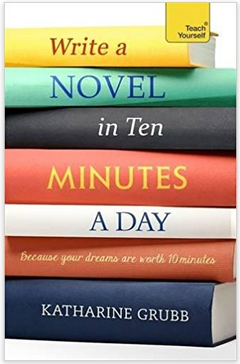
 10. Write a Novel in Ten Minutes a Day
10. Write a Novel in Ten Minutes a Day– Because Your Dreams Are Worth 10 Minutes, by Katharine Grubb
What you will learn: To arrange your writing around your life.
What if you just don’t have time to write, let alone work your way through this list of books for writers? If you put off writing your novel until you ‘have the time’, you’ll never do it. But surely anyone can find 10 minutes a day? That’s why I picked up this book – the title is just so alluring…
Grubb has plenty of advice on story, plot, character, dialogue and structure – but this is also a book about how to find and manage your time. Each chapter contains a practical 10-minute excercise to get you closer to your goal. Though, of course, you’ll also need to find time to read the book…
“Let’s not be intimidated by the task of novel writing. Instead, focus on how you, in very small increments, can sculpt your novel bit by bit.”
– Katharie Grubb, Introduction to Write a Novel in Ten Minutes a Day
What are your favourite books for writers?
How many of these books for writers have you read? Are there any glaring omissions, or additional books for writers you have found useful or inspiring? Do share your recommendations in the comments below.
Save
Save
Save
Save
Save
Save
Save
Save
Save
Save
Save
The post 10 essential books for writers appeared first on Publishing Talk.


August 8, 2017
5 things you need to know about agency agreements
Don’t get too carried away with excitement and gratitude when an agent offers to represent you. Now is the time to put on your business hat and look out for these common pitfalls with agency agreements, says Kirsty McLachlan.

This article first appeared in issue 4 of Publishing Talk Magazine.
4 minutes to read
Hurrah! An offer of representation from a top agent has been made. Do you really need a contract with them? Surely a handshake is fine? Being an author also means donning a business hat sometimes, and ensuring that you and your work are protected. There are snakes out there in the jungle and are best avoided.
As agencies all differ – and so do agency agreements. There are good and bad agreements. Sadly, in the throes of excitement, some writers are blinded to the corrupt nature of some agency agreements. I’ve seen several agreements over the years which have tied an author up in knots even when they have tried to leave an agent. So beware!
5 things you need to watch our for with agency agreements
The following is not an exhaustive list and every agency agreement differs.
1. Payments
All monies should be paid through to the author within 30 days of receipt by the agent (although many agents will agree to 14 days of receipt). There may be some bank charges – especially in the case of foreign payments – but the agreement should state clearly that the author will be charged for these, if that is the case.
It is not standard practice for an agent to charge any further costs. Yet many agents do include charges for photocopying (although these should be minimal), purchase of extra copies for submissions etc. You need to be very clear what deductions will be made and whether or not you get approval over these charges prior to the costs taking place. It’s a sticky matter but I feel, given lots of submissions can be made by email these days, the days of huge postage costs have gone so there is less of an argument for agents to deduct costs.
There should be no upfront fees – reading fees or advance payments – which the author has to make to the agent. Ensure that your agent doesn’t suggest a ‘book doctor’ or ‘editor’ who has a relationship with the agent.
Agency agreements should state the commission that will be taken by the agent. This can range between 10%-20%. It could be a flat 15% for all income, or could have different percentages for income from different sales.
2. Submissions
You should be notified of each submission. You wouldn’t have approval of the submission, but its general practice for you to be consulted.
Any agreement with a publisher should always be subject to the approval of the author. You will be the signatory – unless agreed otherwise – of every agreement.
3. Don’t give your agent power of attorney
Agents shouldn’t be able to sign contracts on your behalf. There are exceptions to the rule – such as if you are out of the country a lot but think hard before agreeing to this. And, again, there should always be some kind of letter expressing this right.
Ensure that you are not granting the agent the rights to a certain book. I’ve seen cases where an author has left an agent but that agent in question still holds rights to a book. To untie the rights at that point is a difficult matter. So ensure that the agent does not have any ongoing rights over a book unsold – or rights such as film rights or foreign translation rights to a book the agent has worked on, on behalf of the author.
4. Termination
What happens if, for whatever reason, the relationship between the agent and the author doesn’t work out? You need a get out clause, and this is called the termination clause. Make sure you are clear about the timeframe. Generally this is between one month and three months notice (following the letter of termination from either party). Any contract negotiated by the agent will stay in place and they will continue to receive commission on those contracts. This is a standard point but one worth understanding. No contract can be altered without the agent’s agreement.
An example of wording for a termination clause is as follows:
This arrangement may be terminated by either party to this agreement by not less than one month’s notice in writing. In the event that this Agreement is terminated, for whatever reason, both parties shall honour all existing Agreements. Any amendments to such Agreements shall only be made with prior written approval of both parties.
5. Non-assignment
Agencies are businesses and can be bought and sold. If you have agreed to be represented by one agency, how would you feel about being sold as an ‘asset’? A non-assignment clause can stop this and will simply state that the agency cannot assign the rights to the agreement to a third party. This is not a standard clause but one I feel important, as more and more agencies are bought up or are joining forces.
The Agency shall not assign their role as Agent – which shall include any services rendered or to be rendered – under any agreement or any part of any agreement made by the Agency to a third party without the Author’s prior written consent.
Finally, don’t forget that both parties then need to sign and date the agreement
Finding an agent is a delight, but you need to feel completely happy with them – both on a business level and a personal one. Meet the agent, ask any questions you want to ask – however, small or seemingly crazy. Take your time to make the right decision and hopefully it will be a long-lasting relationship.
Save
Save
Save
Save
Save
Save
The post 5 things you need to know about agency agreements appeared first on Publishing Talk.


August 3, 2017
10 Twitter hashtags for writers
Hashtags are more important than ever – yet can still be a confusing minefield if you’re new to social media. Here are 10 of the most useful hashtags for writers.
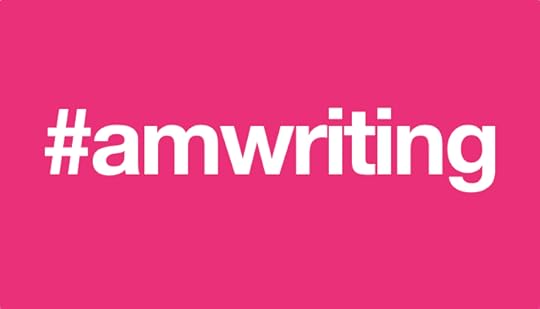
7 minutes to read
Six years ago I wrote a post called ‘10 Twitter Hashtags for Writers.’ It was the 2nd anniversary of the #amwriting hashtag, Twitter was just five years old, and I had recently published an ebook guide to Twitter. Much has changed in the last six years. Today is the 8th anniversary of #amwriting, Twitter has matured into a stroppy pre-teen, and my ebook needs updating. Yet this has remained a popular post – and these hashtags are still used.
Hashtags have not only endured in a fast-changing social media environment, they have become more important than ever. They have since been adopted by Facebook, and especially by Instagram, where their use is arguably even more important than Twitter for making your content findable. They have become so mainstream – ubiquitous, even – that no self-respecting conference or TV show would dare convene or broadcast without announcing an official hashtag.
What are hashtags?
If you’re not yet familiar with hashtags, they are simply words or phrases used in tweets with the # symbol in front of them. Make sure you don’t use any spaces or punctuation, and they become links in Twitter that, when clicked, reveal a timeline of everyone whose tweets contain that hashtag.
The default view shows you the Top tweets using the hashtag you’ve clicked on – but you can also click on Latest in the top menu to see the most recent tweets using your selected hashtag. You can also filter by People, Photos, Videos, News and Broadcasts.
You don’t have to trawl Twitter to find a hashtag to click on – you can also simply type one into the Twitter search box, or go to twitter.com/search.
Use media in your tweets
To make the most of your hashtags, include a relevant weblink where appropriate and where space permits. Images have become more important in Twitter over the last few years too -as have videos and GIFs (short looping videos and animations). You can share video or audio files (such a a link to a YouTube video), which will play directly in your Twitter stream. These all make your tweets far more visible than just a line of text, and you will see plenty of them attached to tweets using the following hashtags.
10 hashtags for writers
There are many hashtags that are useful to help you promote your books, connect with other writers, and – well – write. How do you use them, and which should you use? The 10 hashtags for writers in that original list are still in use. So here is a lightly tweaked version of the original list, plus a few extras, with some updated examples of hashtaggery-in-use.
Click on a few of the following 10 hashtags for writers to get a feel for them and how you might use them. Note that you can use more than one at a time.
1. #amwriting
Writing can be a solitary experience, and Twitter is a great way of connecting with other writers. It’s like a virtual watercooler. #amwriting is the hashtag started by Johanna Harness in 2010 as a way of supporting writers and fostering a sense of community. Use it to tell us what you’re working on, support and learn from others, and share your experience.
Variations on #amwriting include #amediting (if you’re at the editing stage) and #amquerying (writing a query letter or book proposal). If you’re at the editing stage, let people know and ask for any advice you need.
Every. Day. Almost… #amwriting #amediting #amquerying pic.twitter.com/xrOhbKoLu0
— Kimberly Hayle (@kimberlyhayle) August 1, 2017
2. #writerslife
Use this to offer an insight into your life as a writer, your writing process – or a wry comment on what it’s like to be a writer, of the ‘you know you’re a writer when…’ variety.
Writers never stop working, even reading counts as research… #amwriting #writerslife pic.twitter.com/UIp5f3KyFf
— Lacey London (@thelaceylondon) August 2, 2017
3. #WriterWednesday
#WriterWednesday or #ww was originally intended as a way to give shout-out to writers / suggest authors to follow, or to share writing tips. In practice, it also covers pretty much anything else to do with writers or writing too.
I use it quite a lot (on a Wednesday), and even started a weekly paper.li online newspaper called The #WriterWednesday Weekly. This generates its stories from links shared by people on Twitter using #WriterWednesday, and tweets a link to itself. Weekly. On a Wednesday.
Wishing you an awesomely productive #WriterWednesday! ???? #amwriting pic.twitter.com/SxGpjADF7p
— Heather Macht (@AuthorHMacht) August 2, 2017
4. #writetip
While #WriterWednesday is often used to share writing tips, if you specifically want to share or find writing tips, use #writetip or #writingtip.
A story is a series of acts that build to a story climax which brings about absolute and irreversible change.#writingtips #amwriting
— Robert McKee (@McKeeStory) July 30, 2017
5. #wordcount
For some people, regularly sharing your word count in public can be a great way to stay focused. Use it to share your successes (and failures!) and motivate yourself and other writers.
Total #wordcount for July: 20,064 words! Met my goal! #amwriting pic.twitter.com/ilTqSUwrAu
— Amianne Bailey (@AmianneB) July 31, 2017
6. #followfriday
#followfriday or #ff is used on a Friday to suggest people to follow to your followers. Ideally, don’t just include a list of @usernames – tell us why we should follow the person or people you suggest. You can do them one at a time, or include a list of people grouped together by topic or reason.
#ff can help raise your profile too, if people return the favour, or at least thank you in public. This isn’t why you should do it – but it’s an added bonus if it happens. You also use #ff to thank people for helping you in some way.
#ff @publishingtalk @publishingjobs for supporting #bookcareers Salary Survey spon @Inspiredjobs Closes at midnight https://t.co/B2ZQTXMBWD
— bookcareers.com (@bookcareers) July 28, 2017
7. #fridayreads
Another thing you can do on a Friday is tell us what you’re reading. This is a great way of name-checking other authors your admire, often with a picture of the book and short review. You can also use #amreading any day of the week – but #fridayreads is more often used for book reccomendations.
Ideally, include the Twitter @username of the author and official hashtag for the book if either exist; and a buying link to the book. If you have an Amazon Associates account, you might even earn a few dollars (pounds, euros etc.) if people click through and buy your #fridayreads recommendation.
If someone else gives a shoutout to one of your books – whether one that you’ve written, or one that you’ve published – like and/or retweet it on your own Twitter account.
Publishers can use #fridayreads to promote books. I often see them suggesting a Friday Read that happens to be a book that they’ve published that week – sometimes also combined with a giveaway.
You can use #fridayreads to share mini book reviews – whether your own, or quoting someone else’s review.
“#AWrinkleInTime is this beautiful example of creating this other world..” –@TimothyAnne, Curatorial Museum Specialist @NMAAHC✨ #FridayReads pic.twitter.com/dHUdvaioD6
— AmyPoehlerSmartGirls (@smrtgrls) July 28, 2017
8. #writingprompt
Use #writingprompt as a way of engaging with other writers by suggesting a trigger for a story; or to look for writing inspiration yourself. Also check #writingprompts (plural), since this is used too; and maybe throw in an #amwriting for good measure!
Write out the best or the worst day of your life. #writingprompt #amwriting
— Hope N. Griffin (@HopeNGriffin) July 28, 2017
9. #bookgiveaway
Running a book giveaway on Twitter? Use #bookgiveaway to help people discover it. This can be used by publishers or authors. The entry criteria are usually as simple as ‘follow and retweet’ with a closing date. If you win, the person running the giveaway will usually DM (direct message) you to ask where you’d like your book sent.
????GIVEAWAY????????RT + follow for a chance to win 1 hardcover copy of You, Me and Empathy – ends 15/08. #kidlitart #kidlit #bookgiveaway #giveaway pic.twitter.com/1xqzHBRvIH
— Sofia Cardoso (@sofiagcardosoo) July 31, 2017
10. #askagent
You know that you should never pitch to an agent on Twitter, right? They really don’t like it. However, you should follow them, and many are prepared to give advice on Twitter. #askagent is the hashtag to use, which some agents will seek out to answer your questions. #askpub and #askeditor are variations to ask questions of publishers and editors. You can also use #amquerying to send your 140-character pitches out into the world.
Agents will sometimes announce when they’re available for questions using #askagent, with a date and time – or simply if they have a few minutes to spare!
I can do a quick #askagent while kids are in wave pool if anyone has questions?
— Jenny Bent (@jennybent) July 30, 2017
Day-of-the-week hashtags
Consider the following daily hashtags to make yourself more visible on specific days of the week:
#MondayMotivation
#TuesdayMotivation, #CharityTuesday, #TravelTuesday, #TuesdayThoughts
#WriterWednesday, #WednesdayWisdom
#ThursdayThoughts, #ThrowbackThursday / #tbt
#FollowFriday, #FridayReads
#SampleSunday (for sample chapter giveaways)
Seasonal hashtags
Some hashtags work well during specific months or seasons. #SummerReads is a seasonal alternative to #FridayReads. And if you’re doing NaNoWriMo (National Novel Writing Month) in November, find tips and support with #NaNoWriMo or #CampNaNoWriMo.
Genre and topic hashtags
It can sometimes be useful to specify a genre in your tweets – particularly if combined with a #bookgiveaway – such as #crimefiction / #crimefic, #childrensbooks / #kidlit, #yalit, #sciencefiction / #scifi, #romanticfiction, #romcom, #thriller etc.
You can also use hashtags to talk about publishing topics such as #selfpublishing / #selfpub / #indieauthors or #ebooks.
Chat hashtags
You can find various genre and topic-based discussions on Twitter, which sometimes take place at specific times. Try, for example, #YALitChat, #litchat, #scifichat or #scriptchat.
Share your favourite hashtags
What other hashtags for writers have you come across or found useful? Do add them to the comments below.
This is an update of a post that first appeared on this site on 3 Aug 2011.
Save
Save
Save
Save
Save
Save
Save
Save
Save
Save
Save
Save
The post 10 Twitter hashtags for writers appeared first on Publishing Talk.


August 1, 2017
Traditional or indie? Hybrid author Nick Spalding looks at publishing from both sides
Jon Reed asks bestselling hybrid author Nick Spalding about the pros and cons of traditional v. indie publishing.
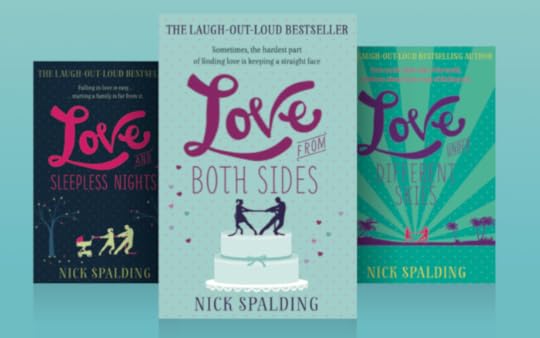
This interview first appeared in issue 4 of Publishing Talk Magazine.
6 minutes to read
Nick Spalding was the UK’s bestselling self-published author of 2012, with two of his Love… trilogy books (Love… From Both Sides and Love… And Sleepless Nights) appearing at #1 and #3 respectively on the KDP bestseller list on Amazon.co.uk. He was snapped up by Hodder & Stoughton imprint Coronet for a six-figure sum in October 2012. Jon Reed asks him how he did it, and which side of the publishing fence is best – traditional or indie?
JR. Congratulations on being the UK’s bestselling self-published author of 2012! How did you achieve this?
NS. My brainwashing machine. I picked it up cheap – second hand from E.L. James. Alternatively… I guess I wrote the right book at the right time for the right people. Let’s face it, the world around us right now isn’t exactly the cheeriest of places, what with double-dip recessions, violent conflicts and Kim Kardashian. I try to make my books as funny as possible, and give readers something to take them away from all that serious, depressing garbage – even if it’s only for the brief time they’ve got their head stuck in the book.
JR. Why did you initially choose to self-publish rather than go with a traditional publisher?
NS. My first book Life… With No Breaks is a weird, experimental little thing – essentially a fictionalized comedy memoir. Selling it to publishers would have been impossible. Self-publishing at Amazon seemed like the ideal thing to do with it. All the other novels have followed on from that book’s modest success.
JR. How did you choose your digital formats and pricing?
NS. Easy. Amazon were at the time (Spring 2010) the only game in town. It was a no-brainer to upload the book to the Amazon Kindle store. Pricing was based on a ‘keep it cheap enough to entice, but still turn a decent profit per copy’ model. I never put any books out for free.
JR. How has the transition to traditional publishing been for you? What are the advantages and disadvantages of traditional publishing?
NS. It’s been very easy so far. Hodder / Coronet and I have worked well together, with good communication and sharing of ideas, and I’ve encountered none of the conflict that I’ve read about other authors having. It’s been a fun process – one that I’m hoping will continue for a long time.
I’d say each self-publisher should decide for themselves whether traditional publishing is the way to go; everyone is different in what they want out of their career. I was happy to relinquish 100% control of my books because of the chance it gave me to break into a wider market. Well… that and the advance they paid me.
The advantages of traditional publishing are:
The weight and experience of a team of people behind you – and all the extra editing, promotion, marketing and salesmanship that the relationship can bring.
The opportunity to enter markets that would not be accessible otherwise – paperback and international, for example.
Did I mention the advance?
The main disadvantage is the inevitable slow down that comes with a third party’s introduction into the publishing process.
JR. How did you get started as a writer? What tips can you offer would-be novelists to get started?
NS. I’ve always written, ever since I was a teenager. It was all terrible, terrible crap, obviously. It took two decades, a lot of words on the page, and several jobs working in the communications industry for me to reach a stage where my writing was good enough to be published.
Sit your arse down in a chair on a daily basis and write until you hit eighty thousand words or your brain explodes – whichever comes first.
The best advice I can give is sit your arse down in a chair on a daily basis and write until you hit eighty thousand words or your brain explodes – whichever comes first. The first thing you have to do if you want to be a writer is get on with it. The second thing you have to do is finish what you started.
JR. How much was writing in a genre a conscious decision for you?
NS. It wasn’t, to be honest. If I have a genre it’s ‘comedy’. The actual setting of the story doesn’t matter to me. While I’m preoccupied with romantic comedies at the moment, I’d like to write humorous books across a whole range of genre as my career goes on. That’s why my book The Cornerstone exists – I wanted to see if I could translate my humour to a fantasy setting. Whether the audience will want me to write in other genre though remains to be seen!
JR. You’ve written a couple of Life… novels in addition to your bestselling Love… trilogy. How important is publishing in a series for self-publishing?
NS. Continuity is certainly never a bad thing. If you can draw readers in with multiple titles with the same ongoing storyline, you increase your chances of growing an audience and building a brand. If you can keep readers in a constant state of expectation for your next work, you’re onto a winner. That job is easier if they’ve already invested themselves in characters and situations that are part of a series.
JR. How does your writing process work? How do you go about planning and writing a novel?
NS. I don’t tend to do too much planning. I have a good idea of the story I want to write and the characters that inhabit it, but that’s about it. I write comedy, which I think always needs a certain degree of spontaneity. If I sat down and planned everything out I’d feel like I was strangling the humour before I’d even got it on the page. Besides, I want to enjoy the story as much while I’m writing it as readers (hopefully) do while they’re reading it. Can’t do that if I’m constantly looking at a cheat sheet!
JR. How an important is marketing for a self-published author? Is this something you enjoy?
NS. Marketing is vital if you’re a self-pubber. You can write a story that would blow the collective minds of every book critic in the world, but if you don’t get it out there and make people aware that the book exists, you’re nowhere.
You can write a story that would blow the collective minds of every book critic in the world, but if you don’t get it out there and make people aware that the book exists, you’re nowhere.
To begin with, marketing was more of a necessary evil than anything. You feel like you’re just one voice shouting in the crowd, which can be a bit disheartening. Luckily for me, I’ve built a platform where I can shout a bit louder these days, which makes the process of marketing more enjoyable. When you know at least a few people out there are listening to you, it can make a positive difference to your enthusiasm level regarding all that promotion and marketing work you’re putting in.
JR. How successful do you find your blog and other social media for promoting your books?
I find social media a convenient way to promote my work and announce any news I might have about future releases or projects, but how much of it has directly led to sales I couldn’t tell you. Probably more so now given that I’ve built an audience than when I started out, I’d say. My initial success was more or less purely down to word of mouth – which is always going to be the most effective way of marketing and promoting when you get right down to it. I really use and enjoy social media more for the opportunity it affords me to communicate with the people who read my books.
Nick Spalding’s Top Tips for Self-Publishing
Get the book finished. You can’t worry about all that marketing and promotional blather until you’ve got a product to sell.
Target your audience. Make sure that what you are writing is something likely to be commercial, mainstream and read by a large amount of people (if you want to make any money, anyway).
Try to have fun with it. It can seem quite daunting when you first start out as a self-pubber, but never let it stress you out too much. There’s a great community of people out there just like you. Get to know them and enjoy the process. No-one ever became successful doing something they hate.
Never miss an opportunity. If you ever get the chance to do an interview with a popular resource like Publishing Talk, make sure the last thing you write is a blatant plug for your work!
Love… From Both Sides, Love… And Sleepless Nights and Love… Under Different Skies are availale in paperback and ebook now.
Follow Nick Spalding on Twitter at @NickSpalding and read his blog at www.nickspalding.com.
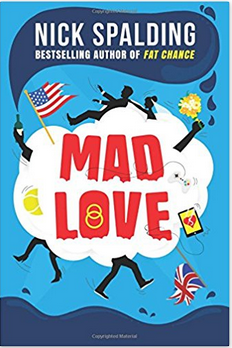 UPDATE: Nick Spalding’s latest books Love… Among the Stars (2015) and Mad Love (2016) are out now.
UPDATE: Nick Spalding’s latest books Love… Among the Stars (2015) and Mad Love (2016) are out now.
Save
Save
Save
Save
Save
Save
Save
The post Traditional or indie? Hybrid author Nick Spalding looks at publishing from both sides appeared first on Publishing Talk.


July 27, 2017
10 ways to use LinkedIn to find a publishing job
LinkedIn is one of the most powerful tools you can use for your publishing job search. Suzanne Collier of bookcareers.com shares her top ten tips for using it effectively.

6 minutes to read
LinkedIn is one the most powerful ways that you can find a new job, locate vacancies or headhunt your next employer (or be headhunted yourself). With over 500 million users (April 2017), LinkedIn compares the whole population of the European Union. To have all those potential contacts at your fingertips, you’ll quickly see how it is a valuable for any jobseeker.
But, as with every social network there are golden rules and pitfalls. Here are my guidelines for making LinkedIn the best part of your publishing job search.
1. Switch off updates
If you are already on LinkedIn and want to try several new things while updating your profile, switch off ‘updates’ so your network and current boss don’t see what you are up to until you have finished making changes. Then , when you are ready, switch updates back on otherwise every time you change your job title or add skills they will get an email ‘Congratulate… on their new job’. Switch updates on and off by going to:
Account & Settings > Privacy Settings > Turn on or off broadcasts – and uncheck the box.
2. Always use your real name and a photograph
It is a good idea to use the same or similar photo as Twitter, if it is a genuine photograph of yourself. This is because that in the rules of marketing there are seven ‘touches’ before you get a sale, and as you are now a brand in yourself you need to create these ‘touches’ within your job search.
If you are apprehensive about putting personal information on the internet, you don’t need to put your whole CV/resumé or career history onto LinkedIn – you can be selective and only list the roles and skills that you feel are important to get you your next role. You might not add in the name of your secondary school for instance. There is a lot of information about you already accessible on the internet; far better that you control your information and your brand, than let others do so for you.
3. Choose your job title carefully
Write a job title which closely matches the role or work you want to do, not the role you may already have. This is because Human Resources and Head Hunters search for people by Job Title. When I looked through LinkedIn I see nothing but ‘Publishing Professionals’. What is a Publishing Professional? How many Human Resources Managers do you think are searching for candidates using the job title ‘Publishing Professional’? I can tell you now, zero.
So choose a job title that is relevant to the work you are looking for or which closely matches the new role that you seek. Editor, Editorial Manager, Editorial Director, Marketing and Editorial Freelance, Marketing Executive/Manager. Your job title on Linked In is the best way to attract the right people to your profile. For instance, since I included the words ‘Career Guidance Strategist’ in my personal LinkedIn Profile, I have had approaches from colleges and universities; when I added in the words Commissioning Editor, I had approaches from Publishers. You don’t need to stick to only one job title; you can have several words and phrases up to around 120 characters.
4. Keep your profile relevant and add in your skills
One of LinkedIn’s recent functions is ‘skills’ and you should list all the skills that you have and that you want to use in a new role. The skills option seems completely flooded with unquantified skills at the moment such as ‘publishing’ – which could mean anything. How the skills option develops or utilised or if it brings any real benefits has yet to be seen – it could be a function to let others ‘touch’ your profile and so you ‘touch’ theirs. Always make it a personal policy to only endorse others who you personally know and are willing to endorse.
5. Ask others for recommendations
Recommendations are testimonials or references written by others about good work or projects you have done. You do not have to recommend in return, although some of your contacts may expect it. A recommendation gives your profile weight – as it shows that others are willing to commit to public a testimonial or reference saying that you have been good at your job. Don’t be afraid to ask others for recommendations, and equally don’t be upset if they refuse or ignore your request.
6. Connect with other people you know
One of the most frequent questions I am asked is ‘who should I connect with?’ Start with current and former colleagues, but again only connect with people that you want to. Don’t feel obliged to accept every connection request and don’t connect with people that you don’t know.
Before you connect with someone, read their profile and under ‘Additional Info’ there may be an item which says ‘Advice for connecting with…’ see if there are any requirements that they have asked for when connecting – for instance, my profile says:
‘Please state the reason for requesting contact or indicate how I know you in your ‘Invitation to Connect’ request. If you do not use your real name on LinkedIn, please don’t expect me to connect. Don’t forget there is a bookcareers.com group on LinkedIn which you are welcome to join’.
It is really important to connect to only those who you know or are really happy to connect to, because if you have not ‘hidden’ your connections, they can then see who you are connected to, and other people may take these as endorsements. It also means that in LinkedIn searches they appear connected to you, and therefore others may feel they need to connect with them too.
7. Personalize your messages
Always send a personal non-standard connection request unless you have already agreed with someone to connect on LinkedIn (although you might want to remind them of your conversation). For instance, in the UK LinkedIn standard messages simply state:
‘I’d like to add you to my professional network on LinkedIn.’
Where it would be much better to send:
‘Further to our conversation (or email or meeting or interview) I would like to connect with you on LinkedIn’.
If you want to connect with people that you don’t know personally a more detailed message is best. For example if you are looking for an editorial role and you want to connect with a publishing recruitment consultant, you might want to send a message such as:
‘I am currently looking for a role within Trade Editorial, I’ve registered on your website but would now personally like to connect with you on LinkedIn’.
Sending a personal message with a connection request should make all the difference, but don’t be surprised if people don’t connect with you or it takes them weeks before they accept your connection request; some people only add connections on a periodic basis.
8. Join relevant LinkedIn Groups
There are thousands of publishing related groups on LinkedIn – including Publishing Talk – and all groups have a page for job vacancies (unless the group owner has disabled this function). Search for the groups which are most relevant to you but, if you are new to LinkedIn, make sure you have at least two connections, otherwise you will be flagged up to the group owner as a potential spammer.
When joining a group, do check the group rules or protocols. For instance, the Bookcareers group on LinkedIn does not allow book or blog promotional posts and those who post find their posts quickly removed.
To ensure that your inbox isn’t flooded with emails from the groups you join on LinkedIn , do make sure that you set your email digests for each group according to your personal requirements. For instance, some groups you might want to receive daily updates, another group you might want a weekly update, and some groups you might want no email updates from at all.
One of the best ways to get yourself ‘noticed’ on LinkedIn, is to ask an appropriate question or post discuss an interesting link you may have seen; but before you do, make sure you’ve monitored the group for a week or so, to see what others are posting and how you may contribute.
9. Update your status
Like Twitter and Facebook you can now update your status on your LinkedIn profile. You can make this public, show to everyone on LinkedIn, or just to your contacts. Remember though this is not Twitter; some people make the same status updates that you would find on Twitter but you have a different, more professional, audience on LinkedIn and sending all your tweets to LinkedIn is not appropriate.
10. Choose companies and people to follow
You can follow companies on LinkedIn, so choose publishers and recruiters who you want to work for now, or aspire to work for in the future. The Publishers who have pages on LinkedIn very often have their own career pages which are regularly updated with new vacancies.
This article first appeared in issue 6 of Publishing Talk Magazine.
Join the Publishing Talk LinkedIn group, or visit our Jobs page for more.
Want to know what publishers earn? Suzanne Collier is currently collecting data for the 2017 bookcareers.com Salary Survey. If you work in UK book publishing or for a literary agency in a salaried role, you have until midnight on Friday 28th July 2017 to contribute. The results are due in September.
See: www.bookcareers.com/salary-survey
Save
Save
The post 10 ways to use LinkedIn to find a publishing job appeared first on Publishing Talk.


July 24, 2017
Why weddings can be murder for Val McDermid
Where does Wire in the Blood creator Val McDermid get her ideas? Danuta Kean investigates.
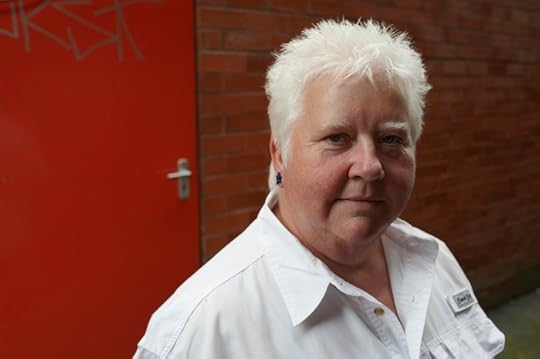
Val McDermid, photographed by Charlie Hopkinson © 2009
This interview first appeared in issue 1 of Publishing Talk Magazine. An edited version first appeared on this site on 20 July 2012.
8 minutes to read
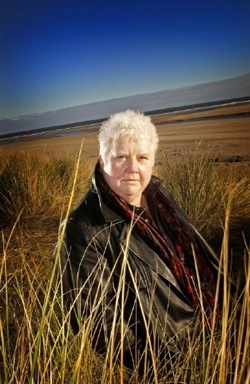
Val McDermid – © Alan Peebles
Weddings can be murder for Val McDermid. As can radio shows, conversations, walks on beaches and even book reviews. For these are among the unlikely inspirations for the crime writer’s 25 bestsellers, including recent UK number one The Retribution (Sphere, 2012).
‘When I started off I thought I had maybe three or four novels in me,’ she explains over a cup of tea on the lawn of St Hilda’s College, Oxford, her old college and where she is hosting a crime writing conference ‘The concept that I would still be full of ideas after 25 books seems bizarre, but there has never been a point in the last 25 years when I have thought, “What am I going to write?”’
The concept that I would still be full of ideas after 25 books seems bizarre, but there has never been a point in the last 25 years when I have thought, “What am I going to write?”
For those of us who struggle to realize one idea McDermid’s admission that she ‘always has at least three ideas at an advanced stage’ in her imagination will be a source of wonder as well as envy. ‘Things come from small beginnings,’ she explains. ‘It can be a throwaway line on the radio or a little anecdote someone shares over dinner.’
If it’s not interesting enough to remember, it’s not interesting enough for a reader to want to read about it.
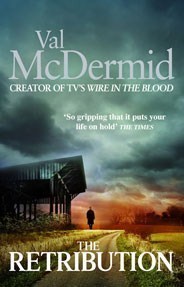 Unlike other writers the Queen of British Noir does not scribble these crumbs of inspiration into a notebook. ‘I work on the principle that if it’s not interesting enough to remember, it’s not interesting enough for a reader to want to read about it.’ Her voice retains the tough, no nonsense tones of her working class roots in Fife, Scotland. It is one of those accents that can make a whisper sound sinister and clashes with our surroundings – a rose garden in an elite English university.
Unlike other writers the Queen of British Noir does not scribble these crumbs of inspiration into a notebook. ‘I work on the principle that if it’s not interesting enough to remember, it’s not interesting enough for a reader to want to read about it.’ Her voice retains the tough, no nonsense tones of her working class roots in Fife, Scotland. It is one of those accents that can make a whisper sound sinister and clashes with our surroundings – a rose garden in an elite English university.
It was from here that she spied the inspiration for Trick of The Dark (Sphere), her 2010 standalone thriller. ‘I was sitting on the lawn just by the river, over there,’ she points towards the banks of the Cherwell, where a girl in a punt trails her hand in the water, while her male companion lazily pushes it along.
‘There was a wedding going on and I saw the wedding party arrive and I recognized the mother of the bride, which started a train of thought about what would be the ramifications of that sort of unexpected encounter?’ Her gaze is fixed on the couple in the punt and I wonder what train of thought they are releasing.
‘I started to think, where could you go with that idea? And by the end of the day, what I thought was that the most interesting thing that could happen would be that the bridegroom would be dead by bedtime.’ She laughs at the admission, a deep, dirty laugh, as guilty as a secret.
Once McDermid has an idea for a book it can take years before it is committed to paper – the inspiration for Trick of the Dark took 12 years to bear fruit. In that time she teases out plot and character details. Much of this incubation is done in her head, though it occasionally seeps out – like her famous creation Dr Tony Hill, McDermid has an unconscious habit of talking to herself.
She can often be spotted walking her dog on the beach near her village home on the Northumberland coast. The dog is a useful foil if anyone passes by worried that the short, middle-aged woman ahead is nattering away to nobody.
Vocalizing her thoughts helps overcome obstacles in stories. ‘I remember in The Last Temptation, one of the key things that had to happen was for this Dutch cop and German cop to share details of a couple of cases they were working on that, on the face of it, didn’t have any connection. Why would they be sharing information?’ she recalls.
‘I was puzzling with it for a while and then was in the shower one morning and shouted out: “Because they are lesbians!”’ She bangs her hands on the bench, her shout cutting through the sedate atmosphere of the garden. Across from us a couple of elderly women look up and laugh.
McDermid’s partner, American publisher Kelly Smith, is used to such outbursts. ‘There was a point yesterday when I was driving down here with Kelly and she suddenly said, “What are you doing? Who are you talking about? Is that the next book?”’ McDermid pulls a face of sweet innocence. ‘”No, I am just singing.”’ A great laugh rips from her belly.
In a world in which authors are pressured to be as presentable as D-list celebrities, McDermid is refreshingly unselfconscious. Dressed in baggy t-shirt and dayglo shorts, her image is at odds with the title most often used by profile writers: Queen of Crime. When I wrote that she looked more like crime’s ‘gobby chief shop steward’, she emailed to say she planned to get it printed as a slogan on a t-shirt.
McDermid goes against type for crime writers in other ways. In a genre where creative writing students are told to plan every detail of their plot, it comes as a surprise to hear the creator of Wire In The Blood (Harper, 1997) starts each novel with nothing written down.
Not that she has always written ‘blind’. Until The Torment of Others (HarperCollins, 2004), her fifteenth novel, she worked to a detailed synopsis, but she hit a wall. ‘It was like wrestling with water,’ she recalls of the crisis. ‘Every time I tried to pin down the rest of the plot it would slither away from me.’
With a deadline looming and in fear that she had finally run out of ideas, she fled to an isolated holiday home in Italy. ‘There is no phone or internet,’ she explains. Each day she would rise early and write solidly until seven, when she would have dinner and a bottle of wine. ‘Then I would go to bed and the next day do exactly the same again.’ Within nine days she had completed 60,000 words. ‘By the end of it I couldn’t speak in sentences.’
In trepidation she sent the book off to her editor, who immediately got back to her extolling it as ‘the best draft’ McDermid had ever produced. The novel went on to win the Theakston’s Old Peculiar Crime Novel of the Year and to be shortlisted for the Crime Writers Association Gold Dagger. ‘I have no fucking idea how that happened,’ she says. Clearly, 10 books on, the trauma of the experience still resonates – as does the liberation of writing without a synopsis: she has not used one since.
The years before writing a novel are spent teasing out its broad structure. When McDermid sits down to write the first 50 pages – usually in late summer – she has a rough idea of where she is going and ‘feels’ her way into it. ‘I then put the manuscript aside and start again in January. Because I have been thinking over it so much, it is at the front of my mind when I start again and it all comes out onto the page.’
The years of careful analysis do not mean McDermid knows every detail when she sits down at her computer again in January. ‘There are still chunks that won’t happen until I get to them,’ she admits. I wonder if the adrenaline rush that comes with such deadline baiting is a throwback to her past as a crime reporter for The People? It does ensure her work has an edge of urgency often lacking in prose dependent on chapter-by-chapter synopsis.
Being able to work to rigid deadlines in her previous career goes some way to explain McDermid’s prodigious output. She kicked off her crime writing careers in the ‘80s with a series featuring gay journalist Lindsay Gordon, which ran to six novels. Since then she has written six featuring private eye Kate Brannigan and seven featuring psychologist Tony Hill and detective Carol Jordan. In between these, she has written a further seven standalone novels.
She says there is a strong difference in writing series and standalone novels. ‘In a standalone book you can allow in the earlier stages for the plot to be paramount.’ As McDermid describes it, there is a Zen-like pleasure in developing character and plot together for a one-off novel.
‘The earlier stages of planning the characters are at the service of the story, and it is only in the process of the writing that you come to an understanding of the characters, which in turn feedbacks into what the possibilities are for the plot and that feeds into the characters….’ She leans back into the wooden bench. Arms out-stretched either side of her, she looks as satisfied as a cat after a saucer of cream.
The great joy of series fiction is you get to spend a long, long time with characters.
Serial novels, she says, offer different pleasures. ‘The great joy of series fiction is you get to spend a long, long time with characters and you can really develop the full richness over a period of time. In a one off novel things can get rushed.’ It is not unknown for her to finish a standalone novel with a strong desire to spend more time with its characters. The first Hill and Jordan novel, The Mermaids Singing (Harper, 1995), started off as a standalone. ‘I just wanted to return to those characters.
The sun disappears behind a great grey cloud and a church bell rings in the distance. I am aware our hour together is closing. McDermid has a paper to present at the conference though she seems in no rush to leave. Before we part I ask her about her support for début crime writers – in recent years she has chaired the New Blood event at the Theakston’s Old Peculiar Crime Writing Festival in Harrogate.
I am excited by what crime writing has become in the past 10 years, the expansiveness of it. The quality is quite astonishing.
She supports new writers because the likes of Reginald Hill and Sue Grafton helped her when she started out. ‘I am also a genuine fan of this genre,’ she adds with a broad smile. ‘I am excited by what crime writing has become in the past 10 years, the expansiveness of it. The quality is quite astonishing.’
Would she like to be starting out again now? ‘No.’ Her mood darkens. ‘I think one of the problems with publishing now is that it has become a very short-term business. I would not want my career to be judged on my first three books.’ Her voice is emphatic. ‘It takes a while to develop the skills that will help you along the way. The way publishing is now, if you haven’t broken by your third book, it’s goodnight Vienna.’
Val McDermid’s Top Tips for Crime Writing
Inspiration: keep an open mind and allow small details to start trains of thought. Then ask questions to see where the idea takes you.
Ideas: if it stays in your memory it is a good idea. If you can’t remember it, it was probably not good enough to sustain a novel.
Synopsis: if you are finding it hard to follow a synopsis, don’t be afraid to tear it up and write ‘blind’.
Character versus plot: serial characters can develop; in one-off novels character needs to be subverted to driving along the plot.
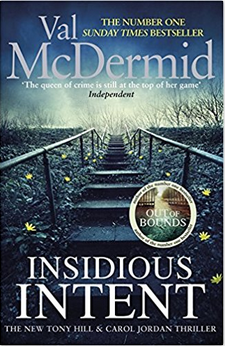 UPDATE: Val McDermid’s latest book, Insidious Intent (Tony Hill and Carol Jordan, Book 10), is published by Little, Brown on 24 August 2017 and is available to pre-order now.
UPDATE: Val McDermid’s latest book, Insidious Intent (Tony Hill and Carol Jordan, Book 10), is published by Little, Brown on 24 August 2017 and is available to pre-order now.
Save
Save
Save
Save
Save
Save
Save
Save
Save
Save
The post Why weddings can be murder for Val McDermid appeared first on Publishing Talk.





